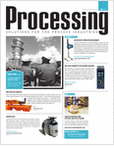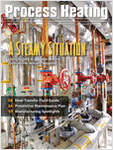Tuesday, July 29, 2008
Display problem ? Click HERE
Have you ever seen or heard about SELF CLEANING HEAT EXCHANGER ?
Recommended :
- Subscribe FREE - Oil, Gas & Petrochem Equipment
- Tips on Succession in FREE Subscription
- Subscribe FREE - Oil, Gas & Petrochem Equipment
- Tips on Succession in FREE Subscription
Operating Principle
The fouling liquid is fed upward through a vertical shell and tube exchanger that has specially designed inlet and outlet channels. Solid particles are also fed at the inlet where an internal flow distribution system provides a uniform distribution of the liquid and suspended particles throughout the internal surface of the bundle. The particles are carried by the upward flow of liquid through the tubes where they impart a mild scraping effect on the wall of the heat exchange tubes, thereby removing any deposit at an early stage of formation. These particles can be cut metal wire, glass or ceramic balls with diameters varying from 1 to 4 mm. At the top of the exchanger the particles disengage from the liquid in a widened outlet channel and are returned to the inlet channel through an external downcomer and are recirculated continuously.
More excellent article and application of Self Cleaning heat exchanger :
- Zero-Fouling’ Self-Cleaning Heat Exchanger
- Principle, Industrial Applications and Operating Installations...
- Developments and Achievements in Self-Cleaning Fluidized Bed Heat Exchangers
- Cost Savings of ‘Zero Fouling’ Crude Oil Preheaters
Labels: Fouling Factor, Heat Exchanger, Shell and Tube Heat Exchanger
Monday, July 28, 2008
Display problem ? Click HERE
Recommended :
Subscribe FREE - Processing Magazine
 Heat Exchangers are a significant part of many industrial processes that involve energy exchange. Most of these heat exchangers become fouled with use. The United Engineering Foundation, which hosts a conference every three years on the fouling problem, estimates that the cost of heat exchanger fouling is 0.4 % of global Gross Domestic Product (UEF, 2001). This high cost has lead to frequent study of the fouling problem, including numerous books and conferences on the subject (Somerscales and Knudsen, 1981; Melo et al., 1988; Bott, 1995). Much of this work has focused on particular industries. Crude oil processing, dairy and food processing, and nuclear reactor cooling are all industries that have conducted a large amount of research aimed at understanding and mitigating fouling.
Heat Exchangers are a significant part of many industrial processes that involve energy exchange. Most of these heat exchangers become fouled with use. The United Engineering Foundation, which hosts a conference every three years on the fouling problem, estimates that the cost of heat exchanger fouling is 0.4 % of global Gross Domestic Product (UEF, 2001). This high cost has lead to frequent study of the fouling problem, including numerous books and conferences on the subject (Somerscales and Knudsen, 1981; Melo et al., 1988; Bott, 1995). Much of this work has focused on particular industries. Crude oil processing, dairy and food processing, and nuclear reactor cooling are all industries that have conducted a large amount of research aimed at understanding and mitigating fouling.
Subscribe FREE - Processing Magazine
 Heat Exchangers are a significant part of many industrial processes that involve energy exchange. Most of these heat exchangers become fouled with use. The United Engineering Foundation, which hosts a conference every three years on the fouling problem, estimates that the cost of heat exchanger fouling is 0.4 % of global Gross Domestic Product (UEF, 2001). This high cost has lead to frequent study of the fouling problem, including numerous books and conferences on the subject (Somerscales and Knudsen, 1981; Melo et al., 1988; Bott, 1995). Much of this work has focused on particular industries. Crude oil processing, dairy and food processing, and nuclear reactor cooling are all industries that have conducted a large amount of research aimed at understanding and mitigating fouling.
Heat Exchangers are a significant part of many industrial processes that involve energy exchange. Most of these heat exchangers become fouled with use. The United Engineering Foundation, which hosts a conference every three years on the fouling problem, estimates that the cost of heat exchanger fouling is 0.4 % of global Gross Domestic Product (UEF, 2001). This high cost has lead to frequent study of the fouling problem, including numerous books and conferences on the subject (Somerscales and Knudsen, 1981; Melo et al., 1988; Bott, 1995). Much of this work has focused on particular industries. Crude oil processing, dairy and food processing, and nuclear reactor cooling are all industries that have conducted a large amount of research aimed at understanding and mitigating fouling.Particulate fouling of HVAC heat exchangers can lead to negative energy and indoor air quality impacts. This work investigated the mechanisms and consequences of particle deposition on fin-and-tube heat exchangers.
Jeffrey SiegelRead more...
Please constantly do heat exchanger maintenance to minimize OPEX.
Related Topics
- Heat Exchanger Fouling Mechanism, Prevention and Treatment...
- Why Lower Fouling factor in Plate Heat Exchanger ?
- Practical Design Tips for Heat Exchanger
- What type of heat exchanger can be used to handle fluid with solid ?
Labels: Heat Exchanger, Shell and Tube Heat Exchanger
Sunday, July 27, 2008
Display problem ? Click HERE
 Heat exchanger fouling has been a headache problem which can not be avoided...however many of us may not aware of it mechanism, prevention and treatment....
Heat exchanger fouling has been a headache problem which can not be avoided...however many of us may not aware of it mechanism, prevention and treatment....Heat Exchanger Fouling Causes Problems In Gas and Liquid System
The article presented six (6) distinctive different mechanism causing Heat Exchangers Fouling e.g. Crystallization, Sedimentation, Chemical reaction & Polymerization, coking, Biological growth and corrosion. This article will only focus on particulate fouling. It discusses particulate fouling mechanisms, prevention and treatment. This article also presented Prediction Model for Particulate Fouling by Kern & Seaton.
by Reza Hashemi and Robert L. Brown, Jr.
Related Topics
The article presented six (6) distinctive different mechanism causing Heat Exchangers Fouling e.g. Crystallization, Sedimentation, Chemical reaction & Polymerization, coking, Biological growth and corrosion. This article will only focus on particulate fouling. It discusses particulate fouling mechanisms, prevention and treatment. This article also presented Prediction Model for Particulate Fouling by Kern & Seaton.
by Reza Hashemi and Robert L. Brown, Jr.
Related Topics
Labels: Fouling Factor, Shell and Tube Heat Exchanger
Monday, August 20, 2007

Basic heat transfer relationships is apply to Air-Cooled Heat Exchanger (ACHE). The fundamental heat ransfer equation :
Q = U. A. LMTD.F
where
U = overall heat transfer coefficientA = Heat transfer area
LMTD = Log mean temperature difference
F = Correction factor
Typical heat transfer coefficient for Air-Cooled Heat Exchangers
Source : DELTA T
Labels: Air Cooler, Heat Exchanger, Heat Transfer, Shell and Tube Heat Exchanger
Thursday, August 16, 2007

Fouling factor is generally used in the design to cater for heat exchanger deficiency resulted by fouling. TEMA has based on many years of experiences and experiments list out fouling factor for Shell & Tube Heat Exchanger for many services. Only TEMA subscribers are eligible to use this information. However, there are several reputable researchers & manufacturers have shared this information to the public. Following are the collection of fouling factors for different service.
- GEO-center (Plate Heat Exchanger)
- Control Around Heat Exchanger
- FAYF - Useful Heat Transfer Equation
- Few Tips on Energy Efficient & Recovery
- Heat Transfer - Internal and External Flow
- FREE E-book........A Heat Transfer Textbook
Labels: Fouling Factor, Heat Exchanger, Shell and Tube Heat Exchanger



